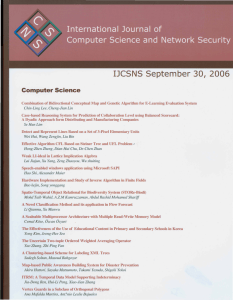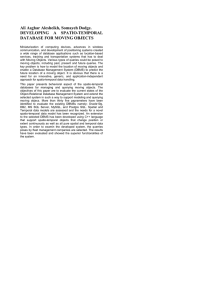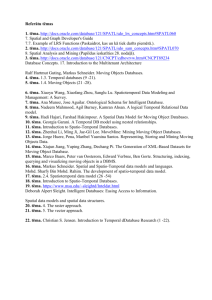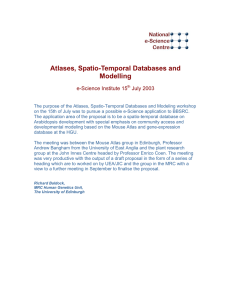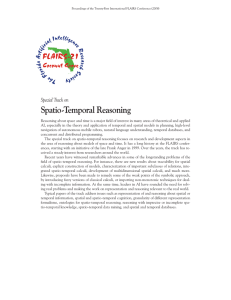Spatio-Temporal Object Relational for Biodiversity System (STORe-Biodi) 45
advertisement
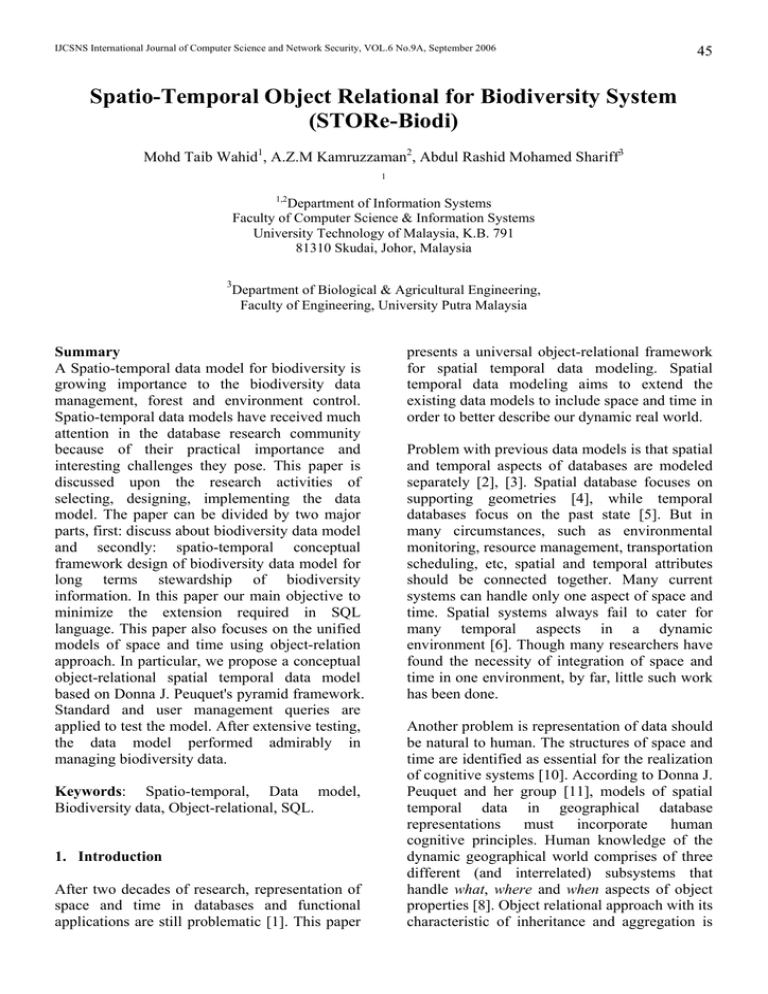
IJCSNS International Journal of Computer Science and Network Security, VOL.6 No.9A, September 2006
45
Spatio-Temporal Object Relational for Biodiversity System
(STORe-Biodi)
Mohd Taib Wahid1, A.Z.M Kamruzzaman2, Abdul Rashid Mohamed Shariff3
1
1,2
Department of Information Systems
Faculty of Computer Science & Information Systems
University Technology of Malaysia, K.B. 791
81310 Skudai, Johor, Malaysia
3
Department of Biological & Agricultural Engineering,
Faculty of Engineering, University Putra Malaysia
Summary
A Spatio-temporal data model for biodiversity is
growing importance to the biodiversity data
management, forest and environment control.
Spatio-temporal data models have received much
attention in the database research community
because of their practical importance and
interesting challenges they pose. This paper is
discussed upon the research activities of
selecting, designing, implementing the data
model. The paper can be divided by two major
parts, first: discuss about biodiversity data model
and secondly: spatio-temporal conceptual
framework design of biodiversity data model for
long terms stewardship of biodiversity
information. In this paper our main objective to
minimize the extension required in SQL
language. This paper also focuses on the unified
models of space and time using object-relation
approach. In particular, we propose a conceptual
object-relational spatial temporal data model
based on Donna J. Peuquet's pyramid framework.
Standard and user management queries are
applied to test the model. After extensive testing,
the data model performed admirably in
managing biodiversity data.
Keywords: Spatio-temporal, Data model,
Biodiversity data, Object-relational, SQL.
1. Introduction
After two decades of research, representation of
space and time in databases and functional
applications are still problematic [1]. This paper
presents a universal object-relational framework
for spatial temporal data modeling. Spatial
temporal data modeling aims to extend the
existing data models to include space and time in
order to better describe our dynamic real world.
Problem with previous data models is that spatial
and temporal aspects of databases are modeled
separately [2], [3]. Spatial database focuses on
supporting geometries [4], while temporal
databases focus on the past state [5]. But in
many circumstances, such as environmental
monitoring, resource management, transportation
scheduling, etc, spatial and temporal attributes
should be connected together. Many current
systems can handle only one aspect of space and
time. Spatial systems always fail to cater for
many temporal aspects in a dynamic
environment [6]. Though many researchers have
found the necessity of integration of space and
time in one environment, by far, little such work
has been done.
Another problem is representation of data should
be natural to human. The structures of space and
time are identified as essential for the realization
of cognitive systems [10]. According to Donna J.
Peuquet and her group [11], models of spatial
temporal data in geographical database
representations must
incorporate human
cognitive principles. Human knowledge of the
dynamic geographical world comprises of three
different (and interrelated) subsystems that
handle what, where and when aspects of object
properties [8]. Object relational approach with its
characteristic of inheritance and aggregation is
46
IJCSNS International Journal of Computer Science and Network Security, VOL.6 No.9A, September 2006
capable of capturing the various notions of space
and time and reflecting them into a single
framework extensible to different applications.
Many database systems concentrate on the
definition of a particular spatial temporal model
that is related to certain application. The result is
that more and more different models appeared.
Each model focuses on a specific set of spatial
temporal features [7]. When encountering other
features and applications, the model doesn't work.
So what we should do is to build an overall
framework that can be extended to various
applications, not driven by various applications
generating different models [8]. Furthermore,
application specific modeling will be more
efficient if it is based on a generic model [9].
To design a biodiversity data model to support
spatio-temporal data, we have chosen pyramid
frame work to support a biodiversity data model
design. The challenge consists in the design of a
spatio-temporal biodiversity data model, in
parallel with the development of appropriate
databases, the development of efficient spatiotemporal biodiversity query languages
inductive analysis of the observation data. In an
object-relational data model consists of a set of
object classes (of different types or schemas).
Each object class has an associated set of
objects; each object has a number of attributes
with values drawn from certain domains or
atomic data types. Of course, there are additional
features, such as object valued attributes (Oid),
methods, object class hierarchies, etc. Besides
objects, attributes describing geometries
including time are of particular interest. Hence
we would like to define collections of abstract
data types, or in fact many-sorted algebras
containing several related types and their
operations, for spatial values changing over time.
This section presents a simple and expressive
system of abstract data types, comprising data
types and encapsulating operations, which may
be integrated into a query language, to yield a
powerful language for querying spatio-temporal
data.
Taxonomy
Knowledge Component
What is it?
Object
What is it made of?
2. Data Modeling Approaches
2.1 Pyramid framework and event based
approach
In the design of object-relational biodiversity
data model to support spatio-temporal data,
pyramid frame can make enhancement to
support a biodiversity data model design. A
conceptual framework (also known as pyramid
framework) was designed which guide the
implementation of the semantic geographical
information system (GIS) data model [21].
Conceptual frame work (pyramid) is interrelated
with two separate parts one is data component
and another is knowledge component (Figure 1).
space’ concept commonly cited in analysis of
remote sensing imagery.
The taxonomy structures groups similar objects
within a category and stores a rule-base that
describes how those objects may be identified
within the data space. These rules may be
derived from expert knowledge or from
Theme Data Component
Where
is it?
Location
Y
When
is it?
Time
T1
T2 T3
X
Figure 1: Pyramid Frame work: Data Component
and Knowledge Component
Figure 2: From the frame work data transform
to the table and time modified as events
To support temporal data, we have applied
another model such as event-based model.
Pyramid system is a model to support multi-
IJCSNS International Journal of Computer Science and Network Security, VOL.6 No.9A, September 2006
dimensional, spatio-temporal and geo-graphic
objects (such as location and space). All the
objects are also placed within two hierarchical
relationship structures central to cognitive
knowledge representational and object-oriented
modeling, plant taxonomy (generalization). The
plant taxonomy structures groups of similar
objects within a category and stores a rule-base
that describes how those objects maybe
identified within the data space. Pyramid
framework consists of main three components;
objects, location and time. These features will be
referred to accessed data from the database. This
framework can be converted to table in stated
Figure 2
After the framework conversion as a table, we
can see that each object has attributes of theme,
space (location) and time. Theme attributes
record the information of “what is this object”
and other related property information. For
example, if the theme of this object is “Forest”, a
Forest must have attributes such as Area or
Province it belongs to, Forest Size, and Forest
Type, etc. Theme can be inherited according to
certain classification hierarchy. For example,
theme can be classified as natural resources
(forest, earth quake, and rainfall), transportation
(rail and highway), settlement (country, city),
water system (river, lake, and pool), and cadastre
etc.
Location attributes record space information of
the object, such as whether it is a point, line, or
polygon, and its location. Location attributes can
be inherited into subclasses such as the point
class, line class and polygon class.
Time attributes are represented through
timestamps associated with theme and location
information. When properties or forest
information of an object changed, a new
timestamp will be recorded for that object. That
means only initial information and changed
information will be recorded. Each timestamp is
an instant. Interval is the time between two
timestamps.
In this model, theme, spatial, time attributes are
recorded as 3 tables. Each attributes use one list.
For example, a flora object has theme attributes
as “Name”, “FloraID”, “FloraType” and
47
spatial attributes as “Area”. During different
season and time of a year, the volume of the lake
will change, and the border of the lake expands
or contracts. Whenever the volume or the border
of the lake changes, a timestamp will be
recorded. Thus, as shown in Figure 3, each
object has a name list, a value (1 to N+1), a
location has area code (1, 2, 3 and n+1) and a
timestamp or events (Day, Month, Year, Second,
minute, hour). Data can be collected same day
same time from different area by different data
collectors. Sometimes data collect from different
forests for several days, months and years. Time
stores as an events records as EventID,
StartTime, Duration and Attributes (types of
data). Diagram bellow indicates fields that can
be used to associate objects between tables.
Figure 3: Relationship between theme, space
and time
There are 3 kinds of relationships among theme,
space and time: one-one, one-many, and manymany. In a one-one relationship, theme, space
and time all changed, such as Value 1- Area 1.
In one to many relationships, one theme attribute
may be related to more spatial attributes and
many timestamps. That means that theme
attribute doesn’t change during this interval
while the spatial attributes changed, such as the
attribute “name”. Also, in some circumstances,
spatial attributes of an object are static while
theme attributes change. Another special case is
that the timestamp list may have just one
element. That means this object is static.
IJCSNS International Journal of Computer Science and Network Security, VOL.6 No.9A, September 2006
48
3. Structure
and
Conceptual
Spatiotemporal Framework for Biodiversity
data
Some research and development of spatiotemporal
object-relational
model
is
experimentally conducted in universal and
several commercial software companies. A few
experimental projects have been conducted
based on TGIS by ESRI, IBM and several
universities all over the world. The TGIS has
been developed based on a relational data model
that tries to overcome the problems of temporal
representation being based on an area event
system. This describes event area, what types of
event occurred, when and where the event
occurred. Event stores all kind of information in
one table (Montgomery, 1995). Temporal
attributes in this table are planned event start
date, event end date and date of event is
superseded by another event. In term of temporal
expressions, there are two main methods of
implementing time in database. The first is to
leave time out of the data model and include it as
an attribute of the data entities. The second is to
include time as an integral part of the data model.
With this implementation of time, the semantics
of the data model are extended to incorporate
time directly in spatio-temporal architecture. In
principle, each spatio-temporal model is based
upon three kinds of data, namely spatial,
temporal and attributes data.
Event Index
Thematic Index
Spatial Index
Space
Spatial Data
Time
Temporal
Theme attribute
Attributes
Biodiversity Data
Figure 4: Spatio-temporal structure
biodiversity data model framework
and
Proposed Data model will be allowed support
biodiversity data alone with temporal data.
Spatio-temporal structure and biodiversity data
model framework (Figure 4) is a combination of
Spatial data, Attribute data and Temporal data.
The three data together represents the values of
attributes on an object occupying a certain
position (spatial data) in the world at a certain
time (temporal data). When dealing with
temporal data, users look for casual relationships
between objects. Events are used for an object
that has both spatial and temporal locations and
extends.
Three data together represents the values of the
attributes of an object occupying a certain
position (spatial data) in the world at a certain
time (temporal data). When dealing with
temporal data, users look for casual relationships
between objects. Events are used for an object
that has both spatial and temporal locations and
extends.
The proposed framework separate themes, time,
and space. The structure’s links describes events
explicitly and can be applied to spatio-temporal
object models. Our proposed model might be
new approach to spatio-temporal biodiversity
information systems, called Spatio-temporal
Object relational Plant Biodiversity (Stop-BDM)
data model that is an increasing controversy in
forest management. Meanwhile, there are few
explanations concerning a temporal object
models associated with temporal objects for
bitemporal database. The proposes data models
is describes by means of collection of one or
more tables that form into a object model and
connected with its relational tables to form an
object-relational data model.
4. Implements the model
To implement and testing our proposed model,
we have used an object-relational database
management system. As a part of the testing,
implementation and evaluation, a biodiversity
data set covering more than 5 years data from
different private and government organizations
such mardi plant genebank data, pahang forest
data and johor national park’s data loaded onto
the database. The physical model is developed
by defining spatial and temporal versions of data
types. For spatial and temporal data types as
combinations of spatio-temporal and standard
IJCSNS International Journal of Computer Science and Network Security, VOL.6 No.9A, September 2006
data types, queries can be differentiated by
which dimensions the desired results are
restricted to, and whether they query for a range
in a dimension or a point. Therefore experiments
on different spatio-temporal queries are
performed with several different selectivity.
4.1 Querying
Operations
with
Spatio-temporal
Our intention is not to devise a new spatiotemporal query language from scratch but to
appropriately extend the widespread database
query language SQL. The main focus is on
integrating developments. We profit from the
fact that the underlying data model rests on the
Abstract Data Type (ADT) approach which
necessitates only conservative extensions to SQL
which are: (i) a set of basic spatiotemporal
predicates, and (ii) an extension mechanism for
new, more complex spatio-temporal predicates.
We call this extended query language STQL
(Spatio-Temporal QueryLanguage). All added
functionality is captured by ADT objects and
operations. The benefit of this approach is the
preservation of well known SQL concepts, the
high-level treatment of spatio-temporal objects,
and the easy incorporation of spatio-temporal
predicates.
The query facility of SQL is provided by the
well known SELCT FROM WHERE clause. The
integration of predicates like “<” or “<>”” for
standard data types such as integers or strings is
well understood. In particular, there are only a
few of them which allow one to include them as
built-in predicates. When considering more
complex and more structured data such as points,
lines, or regions, one can try to systematically
derive all reasonable predicates. Temporally
enhanced object-relational system can express
temporal queries as powerful as those of TSQL2
with only minimal extensions to standard SQL
by using construct such as user-defined functions
and table expressions supported in ObjectRelational systems.
We will consider queries from two (simplified)
application scenarios. The first scenario is
related to biodiversity data (such as flora, fauna)
management which pursues the important goal
of learning from past biodiversity data and their
49
evolution. We assume a database containing
relations with schemas
Flora (FloraName: VARCHAR2, Territory: Species name)
Flora TypeType (ForestArea: VARCHAR2, Extent:
species)
Area (ForestArea: VARCHAR2, Location: Point)
Collectors (CollectorName: VARCHAR2, Actor: Person)
The relation flora records the location and the
development of different species (attribute
Territory) growing and shrinking over time
through clearing, cultivation, and destruction
processes, for example. The relation of flora
collects from different places and it growth of
different data by different people to their
extinction (attribute Extent). The relation
collectors describes about each flora being on
duty from their start at the collection data up to
their return (attribute Location). Figure 5 shows
the results of biodiversity data (flora) has been
collected different times (i. e., spatio-temporal
data) by different persons.
Figure 5: Query to find out all flora name,
colleted time and collector names.
The second scenario, finally, relates to a
database about the migration of birds in order to
explore their behavior patterns over the years.
Birds (Swarm: VARCHAR2, Movement:Point)
4.1 Temporal Selections
The first queries refer to the simple temporal
range query. A temporal selection extracts the
value of an object at a certain instant or the
temporal development over a certain period. We
can then ask queries like “what happened to the
data between days January 10, 1995 to January
20, 1995?”
50
IJCSNS International Journal of Computer Science and Network Security, VOL.6 No.9A, September 2006
SELECT Flora_ID FROM flora
WHERE
(((Flora_collection_year)
01/10/1990# AND #01/20/1995#));
Between
#
This query shows the functional character of a
spatio-temporal object by determining the value
of the object at a certain time through a simple
function application. A more general version of
this query asks what happened to the data
between January 1, 2000 and Dec 20, 2006.
SELECT flora.localname, flora.updt_date, COUNT(*)
FROM (flora INNER join observer ON flora.observer_id
= observer.observer_id)INNER JOIN observation ON
observation.observer_id = observer.observer_id WHERE
((flora.ent_date) BETWEEN '1-Jan-2000' AND '30-Dec2006') GROUP BY flora.localname, flora.updt_date
This operation computes the spatial projection
of a spatio-temporal object for the Johor forest
area. For an evolving region the trajectory
operation returns an object of the spatial type
region which results from projecting the union of
the region values for the Date 20th January, 1990.
The next query asks for the lifespan of a spatiotemporal object: “How many times data have
been collected from Johor before 1995?”
SELECT
COUNT
(Flora_ID)
COLLECTION_DATE AS Ex2
FROM Flora
GROUP BY COLLECTION_DATE
HAVING
(COLLECTION_DATE
(DATETIME, ‘1990-30-12’))
WHERE Area = "Johor"
AS
Ex1,
<CONVERT
The count operator collects the times when the
area Johor is defined (temporalprojection). In
this way inverse temporal functions can be
computed. The duration operation computes the
length of an interval or of several intervals.
4.3 Aggregations
The following query inquires about the largest
collection of flora areas.
Figure 6: query measure the data collected
between two specific dates
The “Between” notation specifies a range of time
values, that is, a time interval. If a spatiotemporal object is applied to a time interval (or a
collection of disjoint time intervals separated by
AND), this expression yields a spatio-temporal
object restricted to that time interval (function
restriction).
4.2 Projections to Space and Time
Projection operations on moving objects map
either to their spatial or to their temporal aspect.
Assume that we are interested in the geometric
locations where the data was changed at the year
January 20, 1990. These can be obtained by:
SELECT Flora_ID, AreaName
FROM Flora, Area
WHERE (((ForestArea =#Johor# AND #01/20/1990#));
SELECT Area (max (Extent)) FROM ForestArea
WHERE Type = "Flora"
The query demonstrates an example of a spatiotemporal aggregation operation max which is an
extension of the well known aggregation
operator in SQL of the same name. It is here
applied to a collection of evolving regions
contained in a relation column and computes a
new evolving region. Internally, this operator is
based on a binary function MAXST applied to two
evolving regions R1 and R2 'and yielding a new
evolving region in the following way:
MAXST (R1, R2):= {(t, r) |t Є time
r MAXgeo
(R1 (t), (R2 (t))}
This definition uses a function MAXgeo which is
applied to two regions R1 and R2 and which
returns larger of both regions.
⎧ r1 If area (r1) > area (r2)
⎨
r
MAXgeo(R1, R2)= ⎩ 2 otherwise
Altogether this means that for 2 evolving regions
R1,…, Rn we first compute the evolving region R
= MAXst (R1,….MAXst(Rn-1, Rn )…). Afterwards,
IJCSNS International Journal of Computer Science and Network Security, VOL.6 No.9A, September 2006
we apply the raise area of R, which computes the
area of R at all times as a temporal real number.
To investigate sustainability, suitability of our
proposed model for handling spatio-temporal
data, we have also made comprehensive
comparison among different feature of STOReBiodi, PAHANG database model, MARDI,
BODHI and JOHOR database models. To fulfill
our comparison, we have stored and manipulated
same data that collected from different
organizations through STORe-Biodi, MARDI,
JOHOR and BODHI database model to perform
a set of defined queries on different data set for
performing different tests such as checking the
model’s suitability for handling the spatial,
temporal and spatio-temporal data. After
applying the certain set of queries, we have
obtained results. To examine the model we have
used a set of user defined queries for support
spatial, temporal and spatio-temporal data. After
experiments and results, we have found that
defined queries results indicate that fast query
response times than other models. This also
meant to present a comprehensive comparison
between the STORe-Biodi and existing BODHI,
MARDI, PAHANG and JOHOR database
models. It has been analyzed that JOHOR,
MARDI database model provides worst
performance regarding handling spatio-temporal
biodiversity data; according to our experiments
we couldn’t get positive results from JOHOR,
and MARDI database models, but we received a
bit better results from PAHANG and BODHI
models, hence we got sufficient quality results
applying the same data using our proposed
model. After applying the certain set of queries,
we have obtained results.
Storage Efficiency
Storage in KB
200
STOP-BDM
150
BODHI
100
PAHANG
MARDI
50
JOHOR
0
2000
4000
6000
8000
10000
Number of Records (in thousands)
Figure 7: Spatio-temporal queries evaluation
among data models
51
The graphical representation of those results
carried out from those database models are
shown in the figure 7:
Figure 7 shows that different spatial, temporal
and spatio-temporal queries applied on those
database models and the above graph results
shown that our proposed models (blue line)
shows the better performance among those data
models for the handling spatio-temporal
biodiversity data. To obtain the results, we have
applied 1000 to 10,000 records and received the
better performance. A pink and yellow line
shows a bit better performance than aqua color.
Purple color line shows the worst performance
during query execution time. During our query
execution not all models support temporal or
spatio-temporal queries. Johor and mardi
database model cannot execute query when data
storage records become higher than 4000 and
6000 accordingly. While our proposed models
not only able to provide the space to run queries
but also produces best results with a very less
time.
5. Discussion
Data model has been developed either spatial
and temporally. In this paper we have discussed
issue of spatio-temporal and data modeling and
query language. A number of data models have
been suggested for a spatio-temporal system.
Some of them are based on the raster approach,
others on the vector approach and yet other
concepts can be applied to both vector and raster
data. Some models are based on the objectoriented paradigm, an approach that is capable of
integrating both vector and raster data into one
data model. This paper takes into consideration
the development of spatio-temporal data model
for biodiversity data and minimizes those
problems.
For
the
first
experimental
investigation purpose, we have tried to applied
johor forest data for the suitability of the model
for handling spatio-temporal data. For this
purposes, we inserted and manipulated the
biodiversity data through proposed model and
perform a specific set of pre-defined temporal
and spatio-temporal queries on it as discussed
above. The proposed model supports well the
spatio-temporal data to perform spatio-temporal
queries.
52
IJCSNS International Journal of Computer Science and Network Security, VOL.6 No.9A, September 2006
6. Future Works
In the light of spatio-temporal issues, there are
great numbers of latent questions associated with
the spatio-temporal cognitive representation,
temporal taxonomies, topological and metric
spatial knowledge, including in implementation
issues for temporal biodiversity, etc. The
performance of the model should be checked
with different and much bigger in size data sets
and more time series data. It would provide
better evaluation if this model could be
compared with other spatio-temporal models in
terms of database size and data accessing time.
Object-Relational database enabling us to trace
biodiversity data with fully function of graphical
visualization and should have an ability to detect
and monitor small changes of forest data
References
[1] Langran, G. (1992), “Time in Geographic
Information Syetems:, Taylor & Francis,
London
[2] Sellis, T. (1999). Research issues in
Spatiotemporal Database Systems, SpringerVerlag Berlin Heidelberg.
[3] Martin Erwig, R. H. G., Markus Schneider,
Michalis Vazirgiannis (1999). “SpatioTemporal Data Types: An Approach to
Modeling and Querying Moving Objects in
Databases.” Geoinformatica 3(3): 269-296.
[4] Guting, R. H. (1994). “An Introduction to
spatial Database Systems.” VLDB Journal 4:
357-399.
[5] Tansel, A. U. and J. Clifford (1993).
Temporal Databases: Theory, Design, and
Implementation,
Benjamin/Cummings
Publishing Company.
[6] Abraham, T. and J. F. Roddick (1999).
“Survey of Spatio-Temporal Databases.”
Geoinformatica 3(1): 61-69.
[7] Goralwalla, I. A., M. T. Ozsu, et al. (1998).
An
Object-Oriented
Framework
for
Temporal Data Models, Springer-Verlag
ABerlin Heidelberg.
[8] Mennis, J. L., D. J. Peuquet, et al. (2000). “A
Conceptual Framework for Incorporating
Cognitive principles into geographical
database
representation.”
International
Journal of Geographical Information System
14(6): 501-520.
[9] Raza, A. and W. Kainz (1999). Cell tuple
based
spatio-temporal
data
model.
th
Proceedings of the 7
international
symposium on Advances in geographic
information systems, ACM Press.
[10] Freksa, C. (1998). Spatial and Temporal
Structures in Cognitive Processes, Springer
Verlag Heidelberg.
[11] Peuquet, D. J. (2001). “Making Space for
Time: Issues in Space-Time Data
Representation.” GeoInformatica 5(1): 1132.
[12] Dieter Pfoser, Nectaria Tryfona, (1998),
“Requirements, definitions, notations for
spatio-temporal application environment”,
Geographic
Information
Systems,
Proceedings of the 6th ACM international
symposium on Advances in geographic
information systems, Washington, D.C.,
United States, Pages: 124 - 130
[13] M. Bouzeghoub, “Morse: a functional query
language and its semantic data model”, proc.
of int. Conf. on Trends an applications of
databases, IEEE-NBS, Gaithersburg, USA,
1994
[14] Xiaoyu Wang, Xiaofang Zhou and Sanglu Lu.
“Spatio-temporal data modeling and
management: A survey”. IEEE TOOLSAsia’00, 2000.
Mohd Taib Wahid
(URL:http://www.is.fs
ksm.utm.my/taib)
received first degree in
Computer
Science
(Information System)
from
University
Technology
of
Malaysia (UTM) in
1996 and Master in Computer Science (Real
Time Software Engineering) in 1998 from
University Technology of Malaysia and
Thomson Campus, France. Currently he is
holding the position of lecturer in the
Department of Information Systems, University
Technology of Malaysia. He is also been
actively involved in many research projects
related data model, contact research project as a
project leader with various public and private
sector. His research interest includes database
design and data modeling, data retrieval, query
optimization and enterprise resource planning.
IJCSNS International Journal of Computer Science and Network Security, VOL.6 No.9A, September 2006
A.Z.M
Kamruzzaman
received his first degree in
Bachelor of Science (Com)
in 2003 from the University
Technology Malaysia and
currently waiting for the
VIVA towards his Master
of Science (Com) at the
same university. His field of
study is spatio-temporal
data modeling for biodiversity data. From
October 2003 to December 2005 he worked as a
research officer with the GIS and biodiversity
data model development research group at the
Department of Information Systems, University
Technology Malaysia. He is the web
administrator and Social and Welfare Secretary
of International Postgraduate Student Society
(IPSS).
Abdul Rashid Mohamed
Shariff
(URL:http://eng.upm.edu.m
y/~rashid/work.htm) has a
PhD in Spatial Information
Science and Engineering
from the University of
Maine, USA. He
is
currently
the
program
manager for GIS and
Spatial Modeling at the Institute of Advanced
Technology in the Universiti Putra Malaysia
(UPM). Dr. Rashid is an active researcher,
having a wide area of interest. Among his
current areas of interest are Spatio-Temporal
Data Models, Biodiversity Databases and
Agricultural Database Management.
53
